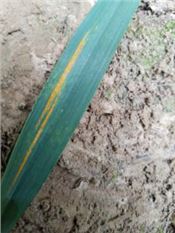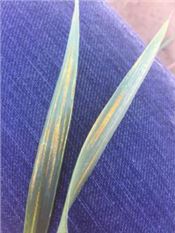Wheat Disease Update
DR. HEATHER MARIE KELLY
JACKSON, TENN.
Additional reports of stripe rust have been coming in across west Tennessee as many fields begin to bloom. Decisions to apply a fungicide to protect not only from stripe rust but also head scab need to be made.
Wheat fields located in Shelby, Tipton, Haywood, Lake, Weakley, Madison, Gibson, and Dyer counties have been reported to have stripe rust in them at low to moderate levels (low-only in the lower canopies, moderate-some flag leaves with rust on them), see images submitted by some consultants.
For more information on stripe rust and telling it apart from leaf rust see the previous blog article – Fungicide considerations and disease identification in wheat at news.utcrops.com.
Wheat fields infected with rust can benefit from a fungicide application and to better guide product choice consultant the Wheat Fungicide Efficacy Table at UTcrops.com that is developed by university plant pathologists in the NCERA-184 Wheat Disease group. Note that solo Strobilurin (Fungicide group 11) products may have reduced efficacy after stripe rust infection has occurred and products containing a Strobilurin (i.e. have Fungicide Group 11 on the label) are not recommended and usually not labeled for application at bloom due to risk of increasing levels of mycotoxin from grain damaged by head scab.
Head scab is the other disease to have on your radar for wheat. With warm temperatures and rain in the forecast while wheat is blooming there is an increased risk for head scab infection. Check the Fusarium Head Blight Prediction Center (www.wheat scab.psu.edu) for risk levels for your area, but be aware of your wheat’s growth stage and your own local weather forecast to better guide fungicide decisions at flowering.
Weather conditions that favor severe head scab/Fusarium head blight (FHB) development include 3 or more days with frequent rainfall, extended periods of high relative humidity, and moderate temperatures (65 to 80°F). These conditions present before, during, and after flowering favor inoculum production, floret infection, and colonization of developing grains. Wheat is susceptible to FHB/head scab infection at flowering (Feekes 10.5) through early dough stage (Feekes 11.2).
I believe blooming wheat fields in Tennessee where rain will occur are at risk for head scab infection and would benefit from a triazole fungicide application (fungicide group 3). Prosaro and Caramba are the top products to apply at bloom for head scab, although will not give 100 percent control, followed by Proline, Tebuconazole products (such as Folicur), and at the bottom is Propiconazole products (such as Tilt). See fungicide efficacy table at https://extension.tennessee.edu/publications/Documents/W341.pdf for exact ratings and rates of products.
Research has shown the most effective timing for controlling FHB and mycotoxin levels is at initial bloom/flowering (Feekes 10.5.1), which relates to at least 50 percent of the heads blooming in a field. Although applications made 5 to 6 days after initial bloom can also provide a benefit in reducing FHB and mycotoxin levels. Applications made at earlier growth stages, such as flag leaf, do not provide any control of FHB and mycotoxin levels. ∆
DR. HEATHER MARIE KELLY: Extension Plant Pathologist, University of Tennessee

Stripe rust reported in Millington, TN

Stripe rust reported in Lake County